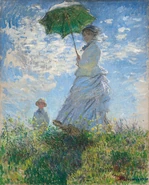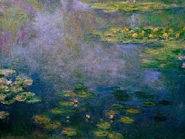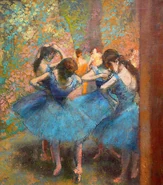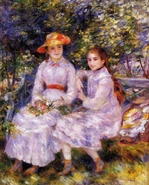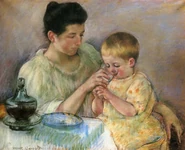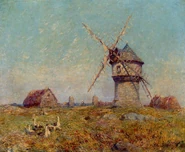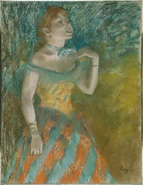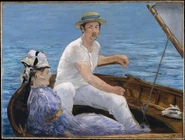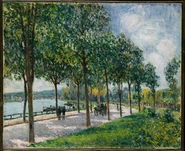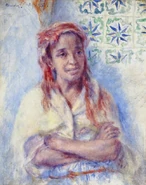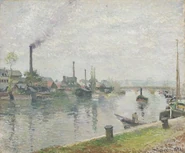m (Removed an item (Edgar Degas) from a list (Notable Artists) that was included twice.) Tag: Visual edit |
(Adding categories) |
||
| (5 intermediate revisions by one other user not shown) | |||
| Line 1: | Line 1: | ||
| − | {{Aesthetic|image1 =LadyWithUmbrella.jpg |decade_of_origin = 1870’s|creator/s=Claude Monet|key_values=expression of motion and moments|related_aesthetics=[[Art Academia]]<br>[[Luminism]]<br>[[Post-Impressionism]]}}'''Impressionism''' |
+ | {{Aesthetic|image1 =LadyWithUmbrella.jpg |decade_of_origin = 1870’s|creator/s=Claude Monet|key_values=expression of motion and moments|related_aesthetics=[[Art Academia]]<br>[[Luminism]]<br>[[Post-Impressionism]]<br>[[Realism]]}}'''Impressionism''' is an art movement that began in France and primarily existed throughout the 1870s-1880s before giving way to [[Post-Impressionism]]. It was pioneered by Claude Monet, Edgar Degas, Pierre-Auguste Renoir, and many others. Impressionist art was an impression of a painting; Impressionist works were first seen as unfinished paintings and significantly criticized because of this. This art movement is also characterized by use of light, as well as landscapes appearing as the main image (instead of as the background of an image). Artists also tended to go outside to paint or see their subjects, instead of keeping in their studios. |
| + | == History == |
||
| − | The Impressionists faced harsh opposition from the conventional art community in France. The name of the style derives from the title of a Claude Monet work, Impression, soleil levant (Impression, Sunrise), which provoked the critic Louis Leroy to coin the term in a satirical review published in the Parisian newspaper Le Charivari. |
||
| + | While Impressionism did not explicitly begin until the 1870s, it has its roots in works and artists prior to this time. Henri Fantin-Latour’s [[Realism|realist]] works occasionally reflected the experimental styles that characterized Impressionism. Johan Jongkind’s and Eugène Boudin’s interest in the portrayal and impact of light were similarly important. Edouard Manet also frequented Impressionist circles; both his techniques and subject matter influenced Impressionism. Manet is sometimes seen as the transition from [[Realism]] to Impressionism. |
||
| + | |||
| + | The first Impressionist exhibition was held in Paris in 1874, and featured Claude Monet, Edgar Degas, Pierre-Auguste Renoir, Camille Pissarro, and Berthe Morisot, amongst many others. <ref>https://www.thoughtco.com/the-first-impressionist-exhibition-183013</ref> It was “greeted with taunts, skepticism . . . the word Impressionism was used by a hostile critic as a derisive term”<ref>Moffett, Charles S. <em>Impressionist and Post-Impressionist Paintings in The Metropolitan Museum of Art</em>. pg. 7 ISBN 0-8109-1104-3.</ref> |
||
| − | The development of Impressionism in the visual arts was soon followed by analogous styles in other media that became known as impressionist music and impressionist literature. |
||
== Visual == |
== Visual == |
||
| + | One of the most important parts of Impressionism was the portrayal of light. This led to the “dabbed” brushwork that is so prominent, as it allowed artists to better portray light in their paintings. The brushwork also made the paintings appear unfinished, as if they were an “impression” of a painting. |
||
| − | ''Under Construction'' |
||
| + | Color also played an important role. Prior to Impressionism, painters frequently applied a varnish that toned down the colors of their works. Impressionist artists rejected this idea. Furthermore, developments in synthetic pigments allowed artists to use new, brighter colors that contrasted previous art styles.<ref>https://www.metmuseum.org/toah/hd/imml/hd_imml.htm</ref> |
||
| ⚫ | |||
| ⚫ | |||
| ⚫ | |||
| + | * Frédéric Bazille |
||
| ⚫ | |||
| + | * Eugène Boudin |
||
| ⚫ | |||
| ⚫ | |||
| ⚫ | |||
| ⚫ | |||
* Mary Stevenson Cassatt |
* Mary Stevenson Cassatt |
||
* Paul Cézanne |
* Paul Cézanne |
||
| ⚫ | |||
| ⚫ | |||
| + | * Paul Guigou |
||
* Vincent Van Gogh |
* Vincent Van Gogh |
||
| ⚫ | |||
| ⚫ | |||
| + | * Berthe Morisot |
||
| ⚫ | |||
| ⚫ | |||
* Alfred Sisley |
* Alfred Sisley |
||
== Gallery == |
== Gallery == |
||
<gallery widths="185"> |
<gallery widths="185"> |
||
| − | LadyWithUmbrella.jpg |
+ | LadyWithUmbrella.jpg|Woman with a Parasol – Madame Monet and Her Son (Monet, 1875) |
Claudemonet.jpg |
Claudemonet.jpg |
||
Edgardegas.jpg |
Edgardegas.jpg |
||
| Line 29: | Line 36: | ||
Cassatt.jpg |
Cassatt.jpg |
||
Puigaudeau.jpg |
Puigaudeau.jpg |
||
| + | Degas-singer-green-1884.jpg|The Singer in Green (Edgar Degas, 1884) |
||
| ⚫ | |||
| + | Manet-boating-1874.jpg|Boating (Edouard Manet, 1874) |
||
| + | Sisley-chestnut-1878.jpg|Allée of Chestnut Trees (Alfred Sisley, 1878) |
||
| + | Renoir-arab-woman.jpg|Old Arab Woman (Pierre-Auguste Renoir, 1882) |
||
| + | Pissarro-lacroix-island.jpg|Lacroix Island at Rouen (Camille Pissarro, 1883) |
||
| ⚫ | |||
| + | |||
| + | == References == |
||
| + | * https://www.tate.org.uk/art/art-terms/i/impressionism |
||
| + | * http://www.visual-arts-cork.com/history-of-art/realism-to-impressionism.htm |
||
| + | * Moffett, Charles S. <em>Impressionist and Post-Impressionist Paintings in The Metropolitan Museum of Art</em>. ISBN 0-8109-1104-3. |
||
| + | |||
| + | |||
[[Category:Visual]] |
[[Category:Visual]] |
||
[[Category:Art]] |
[[Category:Art]] |
||
[[Category:Needs work]] |
[[Category:Needs work]] |
||
[[Category:Art movements]] |
[[Category:Art movements]] |
||
| + | [[Category:Plagiarized]] |
||
| + | [[Category:Ism suffix]] |
||
Revision as of 04:21, 19 July 2021
Impressionism is an art movement that began in France and primarily existed throughout the 1870s-1880s before giving way to Post-Impressionism. It was pioneered by Claude Monet, Edgar Degas, Pierre-Auguste Renoir, and many others. Impressionist art was an impression of a painting; Impressionist works were first seen as unfinished paintings and significantly criticized because of this. This art movement is also characterized by use of light, as well as landscapes appearing as the main image (instead of as the background of an image). Artists also tended to go outside to paint or see their subjects, instead of keeping in their studios.
History
While Impressionism did not explicitly begin until the 1870s, it has its roots in works and artists prior to this time. Henri Fantin-Latour’s realist works occasionally reflected the experimental styles that characterized Impressionism. Johan Jongkind’s and Eugène Boudin’s interest in the portrayal and impact of light were similarly important. Edouard Manet also frequented Impressionist circles; both his techniques and subject matter influenced Impressionism. Manet is sometimes seen as the transition from Realism to Impressionism.
The first Impressionist exhibition was held in Paris in 1874, and featured Claude Monet, Edgar Degas, Pierre-Auguste Renoir, Camille Pissarro, and Berthe Morisot, amongst many others. [1] It was “greeted with taunts, skepticism . . . the word Impressionism was used by a hostile critic as a derisive term”[2]
Visual
One of the most important parts of Impressionism was the portrayal of light. This led to the “dabbed” brushwork that is so prominent, as it allowed artists to better portray light in their paintings. The brushwork also made the paintings appear unfinished, as if they were an “impression” of a painting.
Color also played an important role. Prior to Impressionism, painters frequently applied a varnish that toned down the colors of their works. Impressionist artists rejected this idea. Furthermore, developments in synthetic pigments allowed artists to use new, brighter colors that contrasted previous art styles.[3]
Notable Artists
- Frédéric Bazille
- Eugène Boudin
- Mary Stevenson Cassatt
- Paul Cézanne
- Edgar Degas
- Paul Gauguin
- Paul Guigou
- Vincent Van Gogh
- Édouard Manet
- Oscar-Claude Monet
- Berthe Morisot
- Camille Pissarro
- Pierre-Auguste Renoir
- Alfred Sisley
Gallery
References
- https://www.tate.org.uk/art/art-terms/i/impressionism
- http://www.visual-arts-cork.com/history-of-art/realism-to-impressionism.htm
- Moffett, Charles S. Impressionist and Post-Impressionist Paintings in The Metropolitan Museum of Art. ISBN 0-8109-1104-3.
- ↑ https://www.thoughtco.com/the-first-impressionist-exhibition-183013
- ↑ Moffett, Charles S. Impressionist and Post-Impressionist Paintings in The Metropolitan Museum of Art. pg. 7 ISBN 0-8109-1104-3.
- ↑ https://www.metmuseum.org/toah/hd/imml/hd_imml.htm

